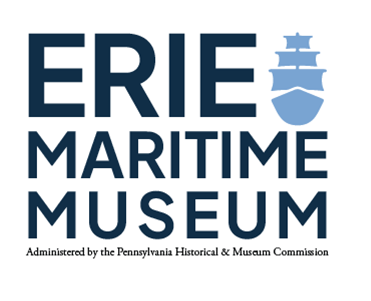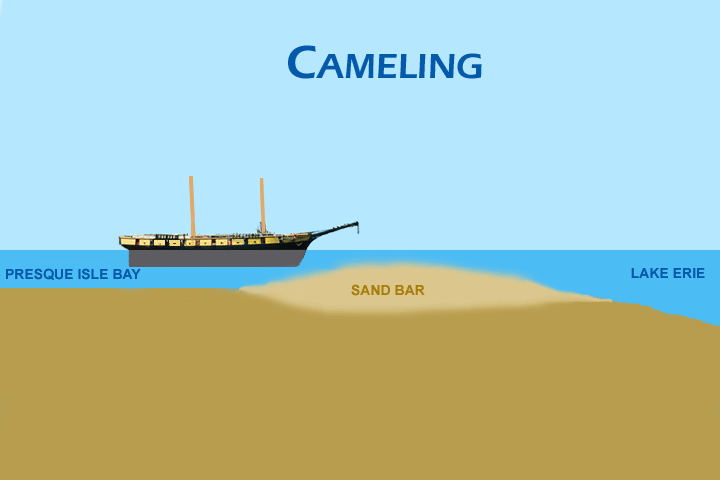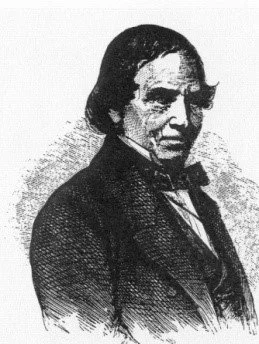Building the Lake Erie Squadron
The chief obstacle for the British in defending Upper Canada was geography. Ocean-going ships could not ascend the St. Lawrence River above Montreal. Thus, the strength of the Royal Navy could not easily be brought to bear, and both sides were starting nearly from scratch. Lake Ontario was separated from Lake Erie by Niagara Falls. Therefore, ships for use on either Ontario or Erie and the other upper Lakes could not be brought in. They had to be built there and could only operate on those waters. In this sense, the British started out with some advantage in already having some warships on the Lakes, but this was offset by the fact that their supply line to bring in materials for new construction was even longer and more difficult than ours.
In 1753, French soldiers traveled from Montreal to establish a fort where the Presque Isle Peninsula formed the finest natural harbor on Lake Erie. They named the place Presque Isle, “almost an island.” The French fort marked the beginning of an overland portage to Fort Le Boeuf, today’s Waterford, on French Creek. From there the French outposts were linked via inland waterways to Fort Duquesne (Pittsburgh) and ultimately, New Orleans. As their fortunes in North America waned, the French were forced to burn Fort Presque Isle in 1759. The British then built a fort at the same site which was ultimately destroyed by Native American warriors during Pontiac’s Rebellion, 1763.
Erie, a Town at Presque Isle, was established in 1795. The 1800 US Census listed 1428 people in Erie County, with 81 living in the town of Erie. By 1812, Erie was a frontier village of 400 or so people and 60 wood buildings. Erie was three days’ travel from the regional commercial center at Pittsburgh, which had a population of 6,000. Other area population centers included Buffalo and Meadville, each with populations of around 500…Cleveland had a mere 50 residents! Erie’s population swelled during the war with 200 men working in the shipyards, 500 sailors to man the vessels, and hundreds of militia called up to defend the town and shipyards. By 1820 Erie had 635 residents, ten years later more than twice that many, and by 1840 the town’s population was 3,412.
“…this is the place for a naval station”
“Erie October 11, 1812
Dear Sir [Lt. Jesse Duncan Elliott]: In regard to the idea entertained by you that this place is not a suitable one to build gunboats at, allow me to differ with you. There is a sufficiency of water on the bar to let them into the lake, but not a sufficiency to let any heavy armed vessel of the enemy into the bay to destroy them. The bay is large and spacious, and completely landlocked, except at the entrance. I have made arrangements in accordance with my own convictions, for the purpose of procuring timber and other materials for their construction. I believe that I have as perfect a knowledge of this lake as any other man on it and I believe you will agree with me, were you here, that this is the place for a naval station.
I remain, very respectfully, etc.”
Courtesy of the William L. Clements Library
The initial effort at building a squadron on Lake Erie was begun by Daniel Dobbins, a local shipmaster, in the winter of l812-13. In March of l813 an experienced New York shipbuilder, Noah Brown, was contracted to take over building the fleet. Oliver Hazard Perry arrived soon after to command the vessels. The task was a daunting one. Skilled shipwrights could only be recruited from East Coast cities and had to be persuaded by high wages to march for weeks through Pennsylvania’s mountainous wilderness, in winter, to reach the frontier outpost of Erie. Everything needed except wood had to come the same way. To house so many men in winter, the first project was to build more log buildings. A larger town needed to be built, before a shipyard could be established, before a fleet could be built.
Requirements Peculiar to this squadron: built fast and cheap, needed [a] shoal draft, less need to carry stores than ocean-going ships.
With the expectation that spring could bring a British attack, the need for speed was the paramount consideration. Timber was instantly available in unlimited quantity. But iron for fastenings, rope, sailcloth, cannon, and ammunition all had to be transported hundreds of miles to reach the squadrons. The naval war on the Lakes has often been called the “shipwright’s war,” in that both sides were dependent upon the skill and speed of the builders before any battles could be fought.
On Lake Ontario, the major U.S. base was at Sackets Harbor, near the St. Lawrence River. The British base was at Kingston. On Lake Erie, the British were building at Amherstburg, across from Detroit, while the U.S. squadron was built at Erie, which offered the only sheltered harbor on our side of the Lake and was not too far from Pittsburgh for shipment of supplies. The builder, Noah Brown, best summed it up: “...though staunchly built, we want no extras. Plain work is all that is required; they will be wanted for only one battle. If we win, that is all that is wanted of them. If the enemy is victorious, the work is good enough to be captured.” While Erie had the Presque Isle peninsula to create a sheltered harbor, the bar at its entrance had at best only six feet of water over it. Lake Erie in general has many shallow areas. Therefore, Niagara had to be built with the shallowest draft possible, consistent with carrying her guns and being able to sail. Even so, the ships still needed to be lightened and lifted over the bar with camels (barges that could be secured alongside, partially flooded, and then pumped out to lift the ship they were attached to).
Animation Courtesy of Timothy McLaughlin
Where Did the Men Come From?
At the beginning of the war, Perry was in command of a squadron of gunboats at Newport. These were small coastal defense vessels, not likely to see much action. Perry put in for a transfer to the Northwest to find action. About 50 of the experienced seamen in the Lake Erie squadron were from the gunboat squadron who requested to transfer with their commander. Another contingent was from the US Frigate Constitution and had seen action already, while others were from warships blockaded in East Coast ports. It is unclear just how many of Perry’s men were experienced seamen, but the number was probably between 170 and 200, about 1/3 of the squadron. The rest of the crews were filled out with locally recruited landsmen, Pennsylvania and Kentucky militia, and various U.S. Regular Army units. Marines in the fleet were a mixture of U.S. Marines, other regular infantry, and militia riflemen.
African-American Seamen in the War of 1812
Seafaring was one of the trades free blacks could participate in with less discrimination than most shore jobs, and they were frequently employed onboard ships. Also, some slaves were hired out by their owners to serve onboard ships, and some officers brought slaves onboard as personal servants/seamen. In the saltwater U.S. Navy of the time, about 20% of the enlisted personnel were black. Although ineligible for officer status, black seamen in this period received the same wages and lived in the same quarters as white seamen of the same rank
It is known that many of Perry’s crew were black but just how many cannot be determined because muster rolls did not list race. The official policy was to limit recruitment to free white males. Each commander, however, was responsible for recruiting for his own ship. The obvious choice when confronted with a need to man the ship was to recruit whoever was qualified and available, but avoid any objections from higher up by not making any mention of race. Even if the 20% average of enlisted men were applied to the Lake Erie squadron, the overall percentage would likely be lower, perhaps 10-15% because officers and warrant officers were exclusively white. Furthermore, many of Perry’s men were from local militia and army units. These units were officially limited to white enlistment. In 1814, Usher Parsons, the Surgeon on Niagara during the battle was quoted as saying “One in six or one in eight was black.” War-time needs led to the inclusion of non-whites, but to what extent is not known.
What can be said is that black seamen served in all theaters of the war, often with distinction. Those who served at Lake Erie were probably among the more experienced seamen, from the pre-war regular Navy, and thus made a significant contribution to this campaign where trained seamen were in short supply. The Royal Navy also recruited free blacks, but again we do not know the precise numbers. Part of the Canadian defense along the Niagara peninsula was the “Colored Regiment,” many of whom were runaway slaves from the U.S. Thus African-Americans served on both sides in this conflict, but identification of individuals has proved difficult.
An ocean-going warship of the same armament and overall size would have been much deeper. This would help the vessel’s overall sailing characteristics but was also necessary to give room to carry fresh water and store it for months at sea on salt water. The Lake Erie squadron could drink out of the Lake and did not have to carry supplies for a long campaign, so the lack of room in the ship was not so much of a handicap. The U.S. Lake Erie Squadron was not ready to sail until August of 1813. The British had more small ships in commission at the beginning of the season but faced identical problems in building their larger vessels.
Due to the bar, the British ships could not enter Erie harbor while the American fleet was still under construction. The British squadron had kept up an active blockade throughout the spring and summer but unexpectedly lifted the blockade to return to Canada, probably for re-supply. Taking advantage of this, Perry moved his vessels over the bar. Lawrence and Niagara had to be floated over the bar without their cannon. The British reappeared before the brigs could be re-armed but did not perceive that their adversaries were temporarily defenseless. Being faced with the larger American force, the British retired up the lake to Amherstburg, near Windsor, Ontario.
Usher Parsons
Disease was the great unseen enemy. Knowledge of sanitation was minimal, and conditions for spreading infection could scarcely be better than a crowded warship utterly lacking in modern sanitation. In one sense a saltwater environment was healthy, in that the surroundings were inherently antiseptic. There was also no chance of drawing drinking water from the same source the heads were discharging into. On the Lakes in a calm anchorage with no tide, the sewage discharge from several hundred men created a real problem. Dysentery was a very common affliction of both sailors and soldiers in the campaigns of the War of 1812. Fevers were also common. All told, up to a quarter of Perry’s men were on the sick list at any given time, including the day of the battle. Perry himself had been suffering from fever the day before.
“Cockpit” was the term given to an area of the lowest deck in a large sailing warship where the wounded would be taken into action. On small warships such as Niagara, the wardroom, or officer’s dining room, was used as the surgeon’s station. Naval battles were essentially close-range artillery duels against tightly packed masses of men in a wooden structure. Compared to land battles fought chiefly with small arms, the carnage was often on a horrendous scale. Aside from outright dismemberment by cannonballs, most of the casualties were caused by wood splinters. A ball smashing through the bulwarks and slamming into a mast or gun carriage would shatter timbers and spray torn wood in all directions. The surgeon’s options were limited to bandaging punctures and lacerations, and amputating shattered limbs. Wounds to organs were most often fatal due to infections. Whiskey was the only anesthetic, and in the heat of battle, the need for speed often prevented serving any.
It was not unusual for up to a third of the crew to be casualties in a hard-fought action, although ten percent was a more common average. 96 U.S. wounded were treated by Surgeon’s Mate Usher Parsons after the battle, and well over one hundred British casualties. Only three died from their wounds, a remarkable achievement. Parsons was not a fully qualified surgeon, but since the surgeons were all too sick to be of help, he had to travel from ship to ship to deal with all the wounded.
Usher Parsons, Surgeon’s Mate





